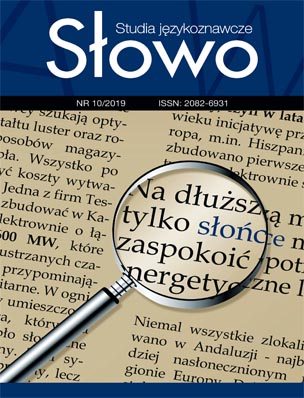Renaming in Urbanonymyas a Form of Foreign Policy Démarche
DOI:
https://doi.org/10.15584/slowo.2019.10.03Słowa kluczowe:
toponymy, urbanonymy, renaming, demarcheAbstrakt
The article presents one of the manifestations of the socio-communicative function of urbanonymy, namely the symbolic role of renaming in the context of foreign policy. The purpose of this article is to establish and describe the signs of foreign policy démarches or similar symbolic acts in renaming (changes in urbanonymy, renominations). To achieve this goal, the author does the lexical-semantic analysis of the concept ‘démarche’ using the induction and deduction methods; the features of démarche were found in certain types of urban renaming of the new period, recorded in the mass media. Finally, with the help of the induction and generalization methods, seven basic criteria for the presence of démarche features in renaming acts are formulated. Materials of the research were presented at the International Scientific-Practical Conference «Language. Society. Journalism» (Kyiv, November 02, 2018).Downloads
Bibliografia
Bondarenko K., 2007, Leonid Kuchma: portrait against the background of the era (Леонід Кучма: портрет на фоні епохи), Kharkiv (Харків).
Dictionary of the Ukrainian Language (Словник української мови): in 11 volumes, 1970–1980 / Academy of Sciences of Ukrainian SSR. Institute of Linguistics; I.K. Bilodid (Ed.), Kyiv (Київ), vol. 2, p. 234.
Halai O., 2008, Extralinguistic factors of the evolution of urbanonymy of Transcarpathian region in the 20th – 21st centuries. (Екстралінгвальні чинники еволюції урбанонімії Закарпатської області у ХХ – ХХІ ст.), «Scientific Bulletin of Uzhgorod National University: Series: Philology» (“Науковий вісник Ужгородського нац. університету: сер.: Філологія”), Vol. 18, pp. 63–68.
Males L.V.,1998, Urbanonymy and State Ideology: Features of Interaction (Урбанонімія і державна ідеологія: особливості взаємодії), «Bulletin: Sociology. Psychology. Pedagogy» (“Вісник Соціологія. Психологія. Педагогіка”), Vol. 6, pp. 21–23.
Neroznak V.P., and Gorbanevskyi, M.V., 1991, Soviet «Newspeak» on a geographical map: On stamps and stereotypes of speech thinking (Советский «новояз» на географической карте: О штампах и стереотипах речевогомышления), Moscow (Москва).
Riznyk O. O., 2007. Toponymic landscape of Kyiv and the issues of state toponymic policy (Топонімічний ландшафт Києва і проблеми державної топонімічної політики) [Electronic resource: http://tram.mashke.org/files/AMY/books/rizniktopolandshaft_2007.pdf (Access Date: 10.01.2019).
Rose-Redwood R.S., 2008, “Sixth avenue is now a memory”: regimes of spatial inscription and the performative limits of the official city-text. “Political Geography”, 27: 875–894.
Rose-Redwood R.S., Alderman D. and Azaryahu M., 2010, Geographies of toponymic inscription: new directions in critical place-name studies, “Progress in Human Geography”, 34(4): 453–470.
Vuolteenaho J., Berg L., 2009, Towards critical toponymies. In Critical Toponymies: The Contested Politics of Place Naming, ed. L. Berg and J. Vuolteenaho, 1–18. Farnham: Ashgate.
Pobrania
Opublikowane
Jak cytować
Numer
Dział
Licencja
Prawa autorskie (c) 2019 Słowo. Studia językoznawcze

Utwór dostępny jest na licencji Creative Commons Uznanie autorstwa – Użycie niekomercyjne 4.0 Międzynarodowe.


